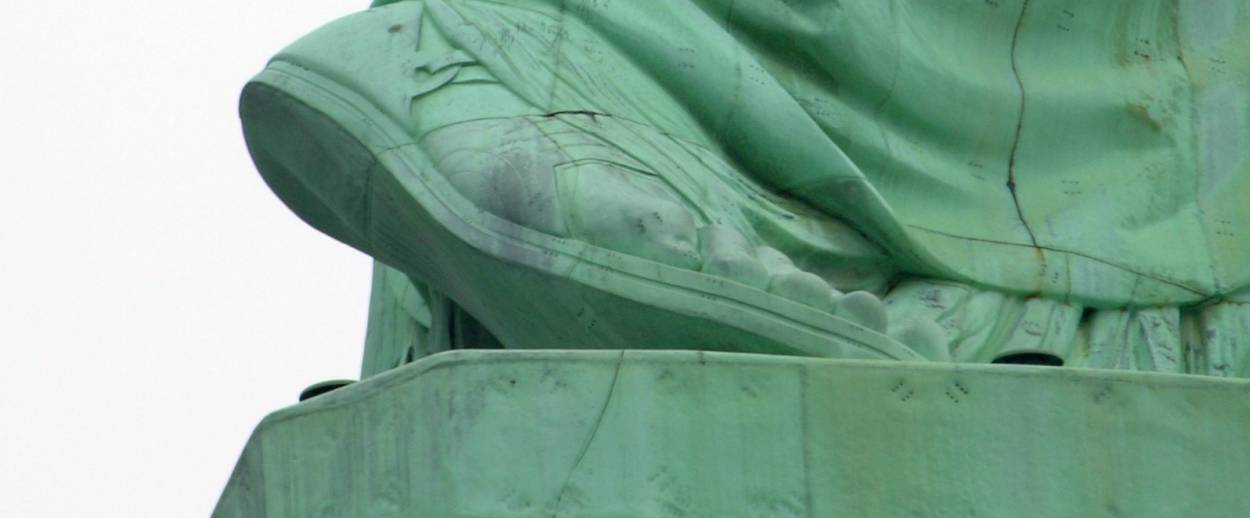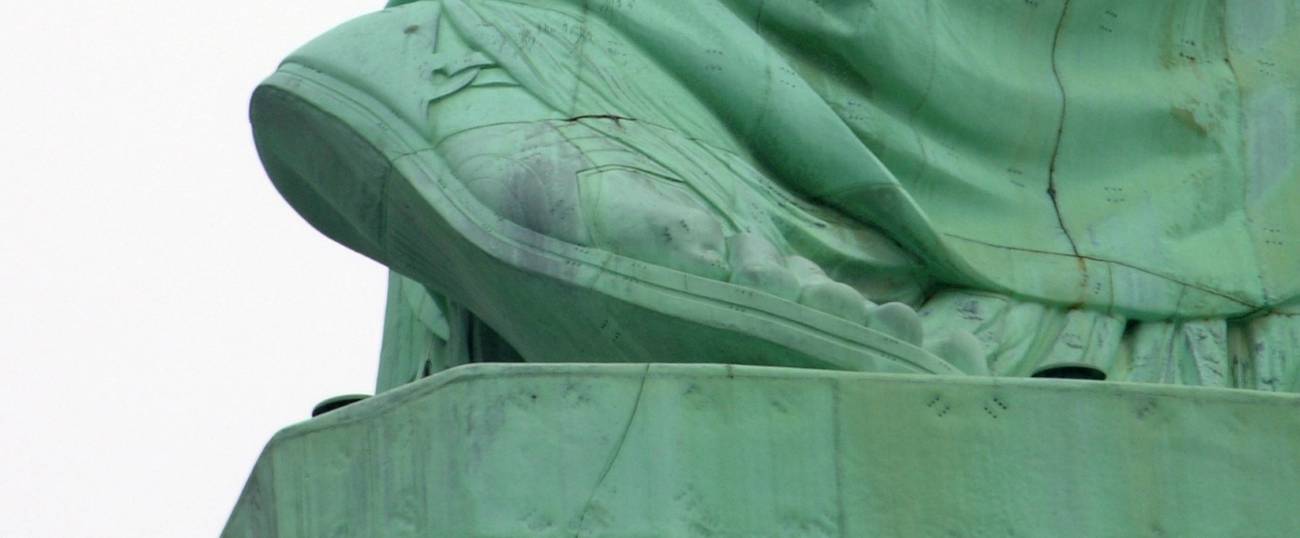The Statue of Liberty Wears a Size 879 Shoe
Dave Eggers’s new children’s book looks at Lady Liberty from a whole new angle




Dave Eggers (yes, that one) has just published a new children’s book about the Statue of Liberty. And it is a doozy.
Her Right Foot is a beautiful, oversized, lusciously-thick-paged hardcover with art by first-time picture book illustrator Shawn Harris. Harris mixes bright and bold India ink with deceptively kidlike and bold construction-paper collage; he and Eggers create an amusing, deadpan history of the Statue of Liberty that winds up being sneakily touching. Her Right Foot has the recursive, self-aware, literary quality of Eggers’s adult work, without being annoying (or worse, pretending to be a book for kids while actually being aimed at arch, too-cool-for-school grownups). And Harris’s art gives Eggers’s text a huge boost, finding the perfect balance between striking + stark and detailed + funny.
Eggers offers us a mixture of normal-looking paragraphs and free verse. Like this, early on:
Did you know that the
Statue of Liberty comes from France?
This is true. This is a factual book.
We learn that Lady Liberty was the idea of Édouard de Laboulaye, who wanted to give the United States a gift for its 100th birthday. He convinced sculptor Frédéric Auguste Bartholdi to do the design. We learn that the statue weighs 450,000 pounds and was shipped to the United States in 214 crates, and that the statue’s copper skin is the thickness of two pennies. Nerd children will love facts like these. Art-loving kids will like the layout–the crammed scenes of Paris (tiny café dogs! croissants! passionate clinches on the street! fancy fashion ladies!) and the way, for instance, Eggers and Harris convey very Fronch annoyance by dropping individual lines of text between oversized spikes of the statue’s crown, when the workers learn that the statue they’ve just assembled in Paris has to be taken down to be sent to America.
“But we just put it together!”
the workers said.
“That is absurd,” they said.
They said all this in French,
the language of the French,
a people who appreciate the absurd.
In one striking spread, we see Bartholdi in wintertime, watching from Battery Park as the Lady rises on what was then called Bedloe’s Island. Bartholdi is a black silhouette hunched against the cold in a greatcoat and tall hat, looking out onto a harbor of broken ice rendered in white snippets of construction paper floating on a pale blue expanse. Lovely.
After the facts comes the musing, and this is where the book gains depth. Harris shows us tons of fun-to-look-at modern-day people jabbering about the statue they’ve come to see – a bearded man in a yarmulke, a little black girl with a green crown and braids, a stylized Little Orphan Annie, a brown dude in Mets cap, an Ellen’s Stardust Diner waitress, a Muslim cleric, a tiny Asian Yankees fan with bobbed hair, an august bewigged judge, and many more –“but no one talks about how she’s walking. This 150-foot woman is on the go!”
Eggers directs us to the statue’s right foot, which is difficult to see from most angles. Her leg is pushed backward; her heel is rising. Where is she going? Eggers points to the broken chains–also difficult to see–around her feet. (He does not mention that de Laboulaye was an abolitionist and president of the French Anti-Slavery Society, or that Bartholdi considered having the statue hold a metaphorically heavy broken chain before deciding this visual was too schismatic, post-Civil-War, so he decided to nestle the chains at her foot, half-hidden in her robes–but hey, you, the grownup reading this book to a child, could volunteer this information. Eggers does not mention Emma Lazarus’s powerful poem, but again, you, the grownup, can.)
Eggers asks us: “If the Statue of Liberty is a symbol of freedom, if the Statue of Liberty has welcomed millions of immigrants to the United States, then how can she stand still?” And because this really is a book for children, Eggers makes his point explicit: “Liberty and freedom from oppression are not things you get or grant by standing around like some kind of statue. No! These are things that require action. Courage. An unwillingness to rest.” We have to become partners in the act of other people’s redemption.
As debates about immigration and refugees became more heated, Chronicle Books moved the release of Her Right Foot from Spring 2018 to October 2017. And the book seems particularly timely as we read the story of Noah in synagogue this weekend. Noah, too, is a story of refugees from disaster, cast adrift at sea, uncertain of the future. It too is a story of “the homeless, tempest-tost,” looking for a lamp beside a golden door.
Marjorie Ingall is a former columnist for Tablet, the author of Mamaleh Knows Best, and a frequent contributor to the New York Times Book Review.